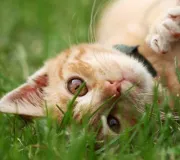Cats come in all sorts of shapes and sizes, but whiskers are one thing that every cat has in common. They’re much more than decorative long hairs sprouting from Fluffy’s snout, too—your pet’s whiskers are essential for all sorts of daily functions. Read on as your local veterinarian tells you more about these important sensory tools.
Whiskers Help Your Cat Navigate Her Environment
Your cat’s whiskers are rooted more deeply into the skin than her normal hairs, and there is a follicle full of nerves at the base of each one. This makes them extremely sensitive. You might be surprised to learn that whiskers are found on more areas of the body than the snout. They also sprout from the chin, ears, eyebrow area, and even the forelegs.
Your cat uses her whiskers to determine the location, size, and texture of objects in her environment, and she can use them to detect changes in air currents. All of this sensory information helps to paint a clear picture of your cat’s surroundings, even if it’s pitch black. Fluffy also uses this information to determine whether or not she can fit into tight spaces, as the whiskers along the nose are about the length of her body’s width.
Whiskers Can Clue You In on Fluffy’s Mood
Did you know that your cat’s whiskers can give you some insight into how she’s feeling? When the whiskers are pulled back tightly across the face, your cat is feeling alarmed or threatened. (This whisker position might be accompanied by wide eyes, raised ears, and a puffed tail.) When the whiskers are relaxed and pointing sideways away from the face area, as they are most of the time, it means your cat is content.
Try to get a good look at your pet’s whiskers the next time she hears a strange sound or the bark of a neighbor’s dog. They’ll probably be adjusted a bit from their normal position.
Whiskers Should Never Be Trimmed>
Cats do shed whiskers occasionally, but you should never attempt to cut or trim them yourself. If you do, you’re removing crucial sensory information that your cat needs, and she could experience dizziness, confusion, and disorientation. It would be like suddenly removing your sense of touch or sight—you wouldn’t like it, either.
While you should never trim your cat’s whiskers, regular claw trimming is an important part of your feline friend’s grooming routine. If you’re unsure about how to safely trim your cat’s claws, check out our article ‘Trimming Your Cat’s Claws‘ for step-by-step guidance and helpful tips.
Does your cat need veterinary care? That’s where we come in. Make an appointment at the office in St. Lucie County, FL today. Regular check-ups through our Vet Preventive Care service can help keep your cat healthy and catch any potential issues early on.

